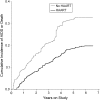Time scale and adjusted survival curves for marginal structural cox models
- PMID: 20139124
- PMCID: PMC2877453
- DOI: 10.1093/aje/kwp418
Time scale and adjusted survival curves for marginal structural cox models
Abstract
Typical applications of marginal structural time-to-event (e.g., Cox) models have used time on study as the time scale. Here, the authors illustrate use of time on treatment as an alternative time scale. In addition, a method is provided for estimating Kaplan-Meier-type survival curves for marginal structural models. For illustration, the authors estimate the total effect of highly active antiretroviral therapy on time to acquired immunodeficiency syndrome (AIDS) or death in 1,498 US men and women infected with human immunodeficiency virus and followed for 6,556 person-years between 1995 and 2002; 323 incident cases of clinical AIDS and 59 deaths occurred. Of the remaining 1,116 participants, 77% were still under observation at the end of follow-up. By using time on study, the hazard ratio for AIDS or death comparing always with never using highly active antiretroviral therapy from the marginal structural model was 0.52 (95% confidence interval: 0.35, 0.76). By using time on treatment, the analogous hazard ratio was 0.44 (95% confidence interval: 0.32, 0.60). In time-to-event analyses, the choice of time scale may have a meaningful impact on estimates of association and precision. In the present example, use of time on treatment yielded a hazard ratio further from the null and more precise than use of time on study as the time scale.
Figures



Similar articles
-
Marginal structural models for case-cohort study designs to estimate the association of antiretroviral therapy initiation with incident AIDS or death.Am J Epidemiol. 2012 Mar 1;175(5):381-90. doi: 10.1093/aje/kwr346. Epub 2012 Feb 1. Am J Epidemiol. 2012. PMID: 22302074 Free PMC article.
-
Using marginal structural measurement-error models to estimate the long-term effect of antiretroviral therapy on incident AIDS or death.Am J Epidemiol. 2010 Jan 1;171(1):113-22. doi: 10.1093/aje/kwp329. Epub 2009 Nov 24. Am J Epidemiol. 2010. PMID: 19934191 Free PMC article.
-
Effect of highly active antiretroviral therapy on time to acquired immunodeficiency syndrome or death using marginal structural models.Am J Epidemiol. 2003 Oct 1;158(7):687-94. doi: 10.1093/aje/kwg206. Am J Epidemiol. 2003. PMID: 14507605
-
Evaluation of the effectiveness of highly active antiretroviral therapy in persons with human immunodeficiency virus using biomarker-based equivalence of disease progression.Am J Epidemiol. 2002 Apr 15;155(8):760-70. doi: 10.1093/aje/155.8.760. Am J Epidemiol. 2002. PMID: 11943695
-
Estimating a time-to-event distribution from right-truncated data in an epidemic: A review of methods.Stat Methods Med Res. 2022 Sep;31(9):1641-1655. doi: 10.1177/09622802211023955. Epub 2021 Dec 21. Stat Methods Med Res. 2022. PMID: 34931911 Free PMC article. Review.
Cited by
-
Prescription of Long-Acting Opioids and Mortality in Patients With Chronic Noncancer Pain.JAMA. 2016 Jun 14;315(22):2415-23. doi: 10.1001/jama.2016.7789. JAMA. 2016. PMID: 27299617 Free PMC article.
-
Relationship between Receipt of a Social Protection Grant for a Child and Second Pregnancy Rates among South African Women: A Cohort Study.PLoS One. 2015 Sep 23;10(9):e0137352. doi: 10.1371/journal.pone.0137352. eCollection 2015. PLoS One. 2015. PMID: 26398678 Free PMC article.
-
Allopurinol, Febuxostat, and Nonuse of Xanthine Oxidoreductase Inhibitor Treatment in Patients Receiving Hemodialysis: A Longitudinal Analysis.Kidney Med. 2024 Aug 28;6(11):100896. doi: 10.1016/j.xkme.2024.100896. eCollection 2024 Nov. Kidney Med. 2024. PMID: 39347518 Free PMC article.
-
Time-Varying Association of Rheumatoid Arthritis Disease Activity to Subsequent Cardiovascular Risk.ACR Open Rheumatol. 2022 Jul;4(7):587-595. doi: 10.1002/acr2.11432. Epub 2022 Apr 10. ACR Open Rheumatol. 2022. PMID: 35403370 Free PMC article.
-
Caucasian Ethnicity, but Not Treatment Cessation is Associated with HBsAg Loss Following Nucleos(t)ide Analogue-Induced HBeAg Seroconversion.Viruses. 2019 Jul 26;11(8):687. doi: 10.3390/v11080687. Viruses. 2019. PMID: 31357522 Free PMC article.
References
-
- Klein JP, Moeschberger ML. Survival Analysis: Techniques for Censored and Truncated Data. New York, NY: Springer; 2003.
-
- Korn EL, Graubard BI, Midthune D. Time-to-event analysis of longitudinal follow-up of a survey: choice of the time-scale. Am J Epidemiol. 1997;145(1):72–80. - PubMed
-
- Lamarca R, Alonso J, Gómez G, et al. Left-truncated data with age as time scale: an alternative for survival analysis in the elderly population. J Gerontol A Biol Sci Med Sci. 1998;53(5):M337–M343. - PubMed
-
- Ray WA. Evaluating medication effects outside of clinical trials: new-user designs. Am J Epidemiol. 2003;158(9):915–920. - PubMed
-
- Robins JM, Hernán MA, Brumback B. Marginal structural models and causal inference in epidemiology. Epidemiology. 2000;11(5):550–560. - PubMed
Publication types
MeSH terms
Grants and funding
- U01 AI037984/AI/NIAID NIH HHS/United States
- UO1-AI-34994/AI/NIAID NIH HHS/United States
- U01 AI031834/AI/NIAID NIH HHS/United States
- UO1-AI-35042/AI/NIAID NIH HHS/United States
- UO1-AI-35040/AI/NIAID NIH HHS/United States
- U01 AI035041/AI/NIAID NIH HHS/United States
- UO1-AI-34993/AI/NIAID NIH HHS/United States
- U01 AI034994/AI/NIAID NIH HHS/United States
- U01 AI035043/AI/NIAID NIH HHS/United States
- U01 AI034993/AI/NIAID NIH HHS/United States
- U01 AI035039/AI/NIAID NIH HHS/United States
- U01 AI035042/AI/NIAID NIH HHS/United States
- UO1-HD-32632/HD/NICHD NIH HHS/United States
- T32 AI007001/AI/NIAID NIH HHS/United States
- UO1-AI-34989/AI/NIAID NIH HHS/United States
- UO1-AI-37984/AI/NIAID NIH HHS/United States
- U01 AI035004/AI/NIAID NIH HHS/United States
- UL1 RR024131/RR/NCRR NIH HHS/United States
- U01 AI034989/AI/NIAID NIH HHS/United States
- T32-AI-07001/AI/NIAID NIH HHS/United States
- U01 AI037613/AI/NIAID NIH HHS/United States
- UO1-AI-35041/AI/NIAID NIH HHS/United States
- R03 AI071763/AI/NIAID NIH HHS/United States
- M01 RR000722/RR/NCRR NIH HHS/United States
- UO1-AI-35004/AI/NIAID NIH HHS/United States
- R03-AI-071763/AI/NIAID NIH HHS/United States
- UO1-AI-35039/AI/NIAID NIH HHS/United States
- R01-AA-01759/AA/NIAAA NIH HHS/United States
- UO1-AI-42590/AI/NIAID NIH HHS/United States
- U01 AI035040/AI/NIAID NIH HHS/United States
- 5-MO1-RR-00722/RR/NCRR NIH HHS/United States
- UO1-AI-31834/AI/NIAID NIH HHS/United States
- UO1-AI-35043/AI/NIAID NIH HHS/United States
- UO1-AI-37613/AI/NIAID NIH HHS/United States
- U01 HD032632/HD/NICHD NIH HHS/United States
- U01 AI042590/AI/NIAID NIH HHS/United States

